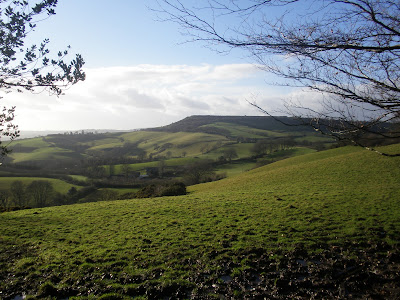This is an ancient landscape and if you look you will see the traces of past civilisations – from the tumuli that form grassy mounds along the skyline, to the roman roads that run straight and true and, often, are still used to day.
But both are part of the ancient landscape of which I speak, for both were Iron Age settlements. This was an area on the border between two of the tribes of that ancient world, the Durotriges to the East and the Dumnonii to the West. What ancient battles did these ramparts see? What lives were lives out on these hills?
The fortifications are better defined on Pilsdon Pen, rampart and ditch, and I stood, on one of the few sunny days this winter, staring out at a landscape that stretched below me. I thought of the people who stood here over millennia past, and looked at this same view, as the landscape changed from forest the field. Did they stand here and watch as the Romans came? Are they watching now?

I love the way you can go over the morphology of the land and see how it was used before. In the US, you can see the ancient, undocumented peoples works of irrigation from over a thousand years ago. They have intricate canals and waterworks, all in the driest parts of the desert. Quit the conundrum.
ReplyDeleteOh how fascinating! To think that what is now a desert was once a farm! :-) And no records of who made thee canals and waterworks - not that is intriguing!
ReplyDeleteGorgeous photo and I love how history is embedded in the soil you stood on. Cool.
ReplyDeleteThanks Lydia :-)
ReplyDeleteInteresting how people leave their mark on the landscape, either consciously-like the people in the iron age or less consciously as in our motorway system. Have you heard Imagined Village playing Pilsden Pen?
ReplyDeleteI'm not familiar with Imagined Village. I'll have to check them out :-)
ReplyDeleteYou can hear it here:
ReplyDeletehttps://www.youtube.com/watch?v=frg0dnWzgp4